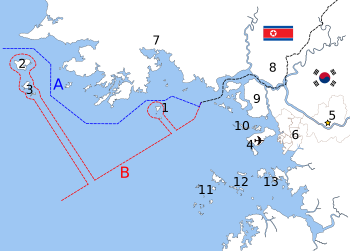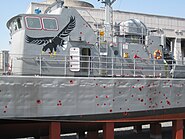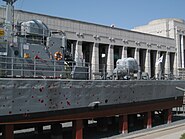The Second Battle of Yeonpyeong was a confrontation at sea between North Korean and South Korean patrol boats along a disputed maritime boundary near Yeonpyeong Island in the Yellow Sea in 2002. This followed a similar confrontation in 1999. Two North Korean patrol boats crossed the contested border and engaged two South Korean patrol boats. The North Koreans withdrew before South Korean reinforcements arrived.
Background[]

The disputed maritime border between North and South Korea in the West Sea:[1]
A: United Nations-created Northern Limit Line, 1953[2]
B: North Korea-declared "Inter-Korean MDL", 1999[3] The locations of specific islands are reflected in the configuration of each maritime boundary, including
- 1–Yeonpyeong Island
- 2–Baengnyeong Island
- 3–Daecheong Island
The Northern Limit Line is considered by South Korea as the sea boundary between itself and North Korea, while North Korea disagrees and states that the boundary is farther south. North Korean fishing vessels often wander into the area and are frequently chased away by South Korean patrol vessels. Occasionally a North Korean patrol tries to enforce its southern claim by traversing the limit line. In 2002 one such incursion turned into a naval battle along the limit line.
Engagement[]
On June 29, 2002 a North Korean patrol boat crossed the northern limit line and was warned to turn back. Shortly afterward a second patrol craft crossed the line and it too was warned to retreat back across the line. The North Korean boats began threatening and harassing the South Korean vessels following them.[4]
After traveling three miles south past the limit line, the North Korean vessels attacked the two South Korean patrol boats that had been monitoring them. At 10:25 The vessel that had crossed the line first opened fire with its 85mm gun and scored a direct hit on the wheelhouse of one of the South Korean craft causing several casualties.[4]
The two squadrons then began a general engagement with the South Koreans using their 40 and 30 mm guns against the North Korean RPGs, 85mm, and 35mm guns. After about ten minutes two more patrol boats and two corvettes reinforced the South Korean vessels and severely damaged one of the North Korean craft. Now heavily outnumbered and taking casualties the North Korean vessels were forced to retreat back across the Limit Line at 10:59.[4]
Aftermath[]
Both the North Korean and South Korean flotillas took casualties from the action. Thirteen North Koreans were killed and twenty five wounded, while four South Korean sailors died and nineteen were injured. The damaged South Korean craft later sank while under tow, while the damaged North Korean vessel was able to limp its way back to port. Both sides laid blame on each other and South Korea demanded an apology from North Korea.[5]
According to a North Korean defector's statement in 2012, the North Korean patrol boat crewmembers involved in the battle suffered extensive splinter injuries from the South Korean "Devastator" shells. The injured North Koreans were reportedly quarantined in a hospital in Pyongyang to hide the extent of the casualties suffered in the battle.[6]
See also[]
- First battle of Yeonpyeong
- Battle of Daecheong
- ROKS Cheonan sinking
- Shelling of Yeonpyeong
Notes[]
- ↑ Ryoo, Moo Bong. (2009). "The Korean Armistice and the Islands," p. 13 (at PDF-p. 21). Strategy research project at the U.S. Army War College; retrieved 26 Nov 2010.
- ↑ "Factbox: What is the Korean Northern Limit Line?" Reuters (UK). November 23, 2010; retrieved 26 Nov 2010.
- ↑ Van Dyke, Jon et al. "The North/South Korea Boundary Dispute in the Yellow (West) Sea," Marine Policy 27 (2003), 143-158; note that "Inter-Korean MDL" is cited because it comes from an academic source and the writers were particular enough to include in quotes as we present it. The broader point is that the maritime demarcation line here is NOT a formal extension of the Military Demarcation Line; compare "NLL—Controversial Sea Border Between S.Korea, DPRK, " People's Daily (PRC), November 21, 2002; retrieved 22 Dec 2010
- ↑ 4.0 4.1 4.2 Ministry of National Defense, Republic of Korea (2002-07-01). "The Naval Clash on the Yellow Sea on 29 June 2002 between South and North Korea". Global Security. http://www.globalsecurity.org/wmd/library/news/dprk/2002/dprk-020701-1.htm.
- ↑ "Nakatani says Koreas situation stable after naval battle". Kyodo News International. 2002-07-02. http://www.thefreelibrary.com/Nakatani+says+Koreas+situation+stable+after+naval+battle-a088685568.
- ↑ The Dong-a Ilbo, "NK Soldiers Wanted S. Korean Flak Jackets In 2002 Battle", 20 June 2012
References[]
- Fackler, Martin (2009-06-23). "Yeonpyeong Island Journal - In Clash Between Koreas, Fishermen Feel First Bite". New York Times. http://www.nytimes.com/2009/06/24/world/asia/24korea.html.
- Van Dyke, Jon M., Mark J. Valencia and Jenny Miller Garmendia. "The North/South Korea Boundary Dispute in the Yellow (West) Sea,". Marine Policy 27 (2003), 143-158.
The original article can be found at Second Battle of Yeonpyeong and the edit history here.




